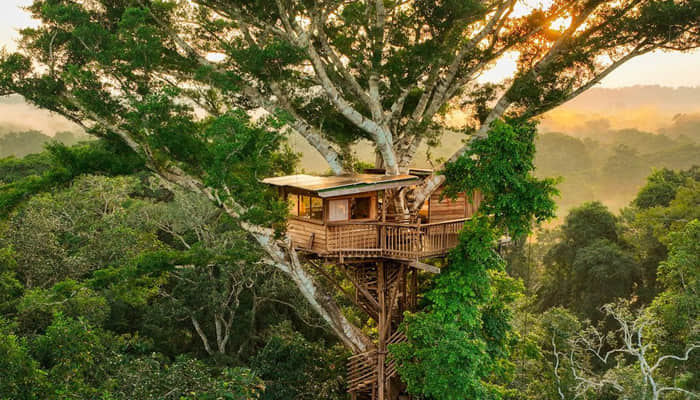
Serengeti National Park, Tanzania
The Serengeti is a must-visit if you’re dreaming of photographing wild animals in their natural habitat. Located in Tanzania, this iconic park is home to the famous Great Migration, where millions of wildebeests, zebras, and gazelles move across the plains. It’s not just about the migration—you’ll also find lions, leopards, cheetahs, elephants, and so much more, all living freely under the vast African sky.
The golden light of sunrise and sunset makes this place a paradise for wildlife photographers. You can capture stunning images of predators on the prowl, playful baby animals, and dramatic interactions between species. Whether you’re using a professional DSLR or a beginner camera, the Serengeti’s open landscapes and incredible wildlife density make it easier to get that perfect shot.
Yellowstone National Park, USA
Yellowstone is one of the best places in North America for wildlife photography. Nestled mostly in Wyoming, it’s known for its geothermal wonders, but it’s also a haven for animals like bison, elk, wolves, grizzly bears, and bald eagles. The park offers a fantastic mix of scenery and wildlife, especially in Lamar Valley, often called “America’s Serengeti.”
You can visit Yellowstone in all seasons, but each time of year offers something special. In spring, you’ll see baby animals and lush greenery. Winter brings dramatic snow-covered landscapes and better chances of spotting elusive wolves. The park’s accessibility and variety make it a great choice for amateur and seasoned photographers.
Galápagos Islands, Ecuador
The Galápagos Islands are like no other place on Earth. These volcanic islands off the coast of Ecuador are bursting with unique animals you won’t find anywhere else. Think giant tortoises, marine iguanas, and blue-footed boobies. Moreover, many animals have no fear of humans, making getting up close and personal with your camera easier.
Because the wildlife here evolved with little exposure to predators, they often come very close to people. You can snorkel with sea lions, walk beside curious birds, or photograph a resting iguana without a telephoto lens. The Galápagos are ideal for nature lovers and offer unforgettable photo opportunities at every turn.
Ranthambore National Park, India
If photographing wild tigers is on your bucket list, Ranthambore is the place to be. Located in Rajasthan, India, this national park is known for its high tiger density and incredible scenery. The old ruins and dry forests give your photos a dramatic backdrop, adding more depth to your shots.
Ranthambore is also home to leopards, sloth bears, marsh crocodiles, and various birds, making it a diverse location for wildlife photography. Safari rides in open jeeps provide excellent opportunities to spot and photograph tigers in the wild. The excitement of seeing a tiger in its natural environment is hard to describe—it’s simply magical.
Pantanal, Brazil
While many people think of the Amazon for wildlife in Brazil, the Pantanal is the better photographer choice. It’s the world’s largest tropical wetland and offers some of the best chances to spot elusive animals like jaguars, giant otters, and capybaras. The open landscapes make wildlife easier to see and photograph than the dense Amazon rainforest.
The Pantanal is also a birdwatcher’s paradise, with colorful species like the hyacinth macaw and jabiru stork. Boat trips along the rivers let you photograph animals from a new angle, and early mornings provide beautiful light for photography. If you’re serious about capturing rare wildlife, the Pantanal is an underrated gem you shouldn’t miss.
Masai Mara, Kenya
Just across the border from the Serengeti lies Kenya’s Masai Mara, another legendary spot for wildlife photography. It’s particularly famous for its annual wildebeest migration and the predators that follow them. Lions, cheetahs, and hyenas are commonly seen here, often within a short drive from your lodge or camp.
The Masai Mara is perfect for close encounters with wildlife. The open grasslands give you unobstructed views and experienced guides can help position you for the best shots. The cultural experience of meeting the Maasai people adds another layer of storytelling to your photo adventure.
Borneo, Malaysia/Indonesia
Suppose you’re looking for something different, head to Borneo for a chance to photograph orangutans in the wild. These incredible primates share 97% of their DNA with humans, and watching them swing through the trees is both moving and magical. The rainforests of Borneo are also home to pygmy elephants, clouded leopards, and a variety of exotic birds.
Photographing in a rainforest has challenges—like humidity, limited light, and dense foliage—but the rewards are well worth it. Use fast lenses and be patient. Whether trekking through the jungle or visiting a rehabilitation center, Borneo offers intimate and emotional photography experiences that are truly one of a kind.
South Georgia and the Falkland Islands
If you’re into photographing cold-climate wildlife, South Georgia and the Falkland Islands are a dream. These remote islands in the South Atlantic Ocean are home to massive colonies of king penguins, elephant seals, and albatrosses. The sheer number of animals here is jaw-dropping and offers endless photo opportunities.
These places are accessible by cruise ship, usually as part of an Antarctic expedition. The landscapes—snowy mountains, rocky beaches, and icy waters—add drama to every image. The wildlife is not shy, so you can get surprisingly close, making it a top pick for wildlife photographers who crave something off the beaten path.
Kruger National Park, South Africa
For good reason, Kruger is one of Africa’s oldest and most famous game reserves. It’s incredibly easy to explore on a guided safari or a self-drive adventure. The park is known for the “Big Five”—lion, leopard, rhino, elephant, and buffalo—and countless birds and smaller creatures.
What makes Kruger great for photographers is the variety of habitats and the ease of access. There are many rest camps with accommodations inside the park, so you can be out at dawn to catch the best light. With some luck and patience, you can capture dramatic moments that feel like they came straight out of a nature documentary.
